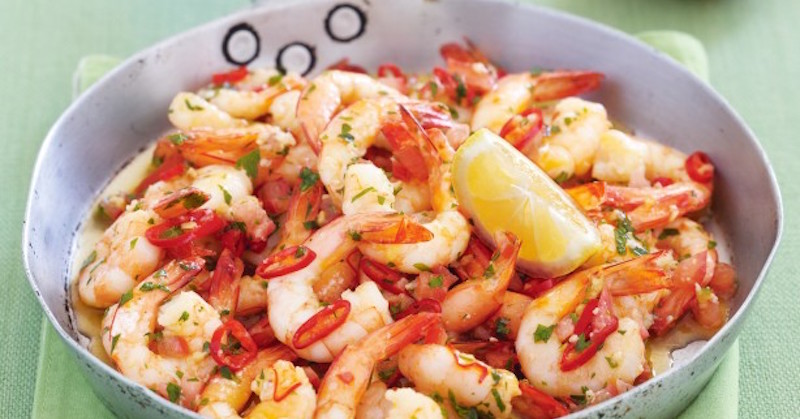Most Seafood Is Contaminated With Heavy Metals. Try This Safe, Nutritious Shrimp Recipe Instead
Last updated on
I have cautioned against consuming most seafood due to the potential of having widespread contamination. Many varieties of fish today come from polluted waters and are tainted with mercury, PCBs, and other potentially toxic heavy metals that can do serious damage to your health.
Did You Know?
- Shrimps, due to their small size, are one of the safer kinds of seafood that you can consume—as long as they’re obtained from fresh, clean, and trustworthy sources and not farmed
- When purchasing fresh wild-caught shrimps, look for those that are shiny and do not have any black spots. They shouldn’t be slimy and should have no ammonia-like odor, which are signs that the shrimps are going bad
- This shrimp recipe is loaded with flavors from some of the most health-promoting spices found in your kitchen cupboard—namely garlic, ginger, and red chilies
- Look for shrimps and other seafood products certified by the Marine Stewardship Council (MSC). Seafood Watch can also guide you in the direction of more sustainable seafood choices.
However, I believe that shrimps, due to their small size, are one of the safer kinds of seafood that you can consume—as long as it is obtained from fresh, clean, and trustworthy sources.
If you can find a safe source of shrimps, I recommend whipping up this simple but truly flavorful sautéed shrimp recipe.
Chili Garlic Ginger Shrimp
Ingredients:
- ¼ cup coconut oil
- 2-inch piece of fresh ginger, minced
- 2 cloves of garlic, minced
- 2 fresh red chilies, seeds removed and thinly sliced
- 16 large shrimps (16 ounces), peeled and deveined
- 1-2 lemons, to taste
- ½ cup Italian parsley, roughly chopped
- Sea salt and freshly ground pepper
Procedure:
- Heat a large sauté pan over medium high heat. Add coconut oil, ginger, garlic, chili, and shrimps. Cook for about 3 minutes, stirring often.
- Turn the heat to low and add the juice of 1 lemon. Stir in parsley. Remove from heat.
- Taste the sauce and add salt and pepper, and more lemon juice if desired.
This recipe makes 4 servings.
(From Healthy Recipes for Your Nutritional Type)
Chili Garlic Ginger Shrimp Cooking Tips
If obtained from fresh, clean sources, shrimps are an excellent and nutritious food that can be served in various ways—whether as an hors d’ oeuvre, main dish, or even added to soups and salads. The key is finding wild shrimps harvested from the cleanest cold water sources.
Before deveining and shelling the shrimps, make sure you rinse them thoroughly. To devein, simply peel the shell using a paring knife and make a shallow slit along the back, from the head to the tail. Look for the black sand vein running along the center of the back. Using the tip of the knife, carefully remove and discard the vein. Rinse again under cold water.
Shrimps cook very quickly, usually taking two to four minutes (depending on their size). Once they have started to curl up and turned a nice pink or light orange color, they’re cooked.
Why Is Chili Garlic Ginger Shrimp Good for You?
Fresh, wild-caught shrimps are an excellent health food that contains various nutrients like:
- Vitamin B12
- Tryptophan (an essential amino acid)
- Healthful fats like omega-3s, saturated fat, and cholesterol
- Selenium (Research shows that the selenium in shrimps can be well-absorbed by the human body)
- Astaxanthin
- High-quality protein (WHFoods3 actually ranks it as the eighth best food source of protein)
Ginger
Not only is ginger a wonderful (and fragrant) addition to your cooking, but it also has a wide array of medicinal properties that can fill several books. That’s why it’s one spice that I recommend having in your kitchen at all times.
Ginger is a rich source of antioxidants such as zingerones, gingerols, and shogaols. It also has broad-spectrum antiviral, antibacterial, and antiparasitic properties. If unpeeled, ginger can stay fresh in your refrigerator for up to three weeks, or in your freezer for six months or longer.
Garlic
Fresh garlic, despite its slightly pungent odor, is a potent herb with antibacterial, antifungal, and antiviral properties although its therapeutic effects may go much further than that. The benefits of garlic come from its sulfur-containing compounds, such as allicin. Oligosaccharides, selenium, arginine-rich proteins, and flavonoids also give it its health-promoting qualities.
If stored properly, garlic will stay fresh for about a month. Keep it in an uncovered container away from heat and sunlight, to prevent it from sprouting.
Chilies
The spicy flavor of chilies comes from capsaicin, an odorless and colorless compound that is produced to protect the peppers from fungal attack. When you eat it, it tricks your brain into perceiving heat where it touches your body.
Capsaicin is found to help alleviate pain by depleting your body’s supply of substance P, a chemical component of nerve cells that is necessary for transmitting pain signals to your brain. This compound also de-sensitizes your skin’s sensory receptors.
The antioxidant and anti-inflammatory properties of capsaicin may also have some benefits against cancer. For example, it was found that capsaicin suppresses the growth of human prostate cancer cells, but leaves normal cells unharmed.
This article was originally published on Mercola.com. It is republished here with permission.
Some of the links I post on this site are affiliate links. If you go through them to make a purchase, I will earn a small commission (at no additional cost to you). However, note that I’m recommending these products because of their quality and that I have good experience using them, not because of the commission to be made.


































 JOIN OVER
JOIN OVER
Comments